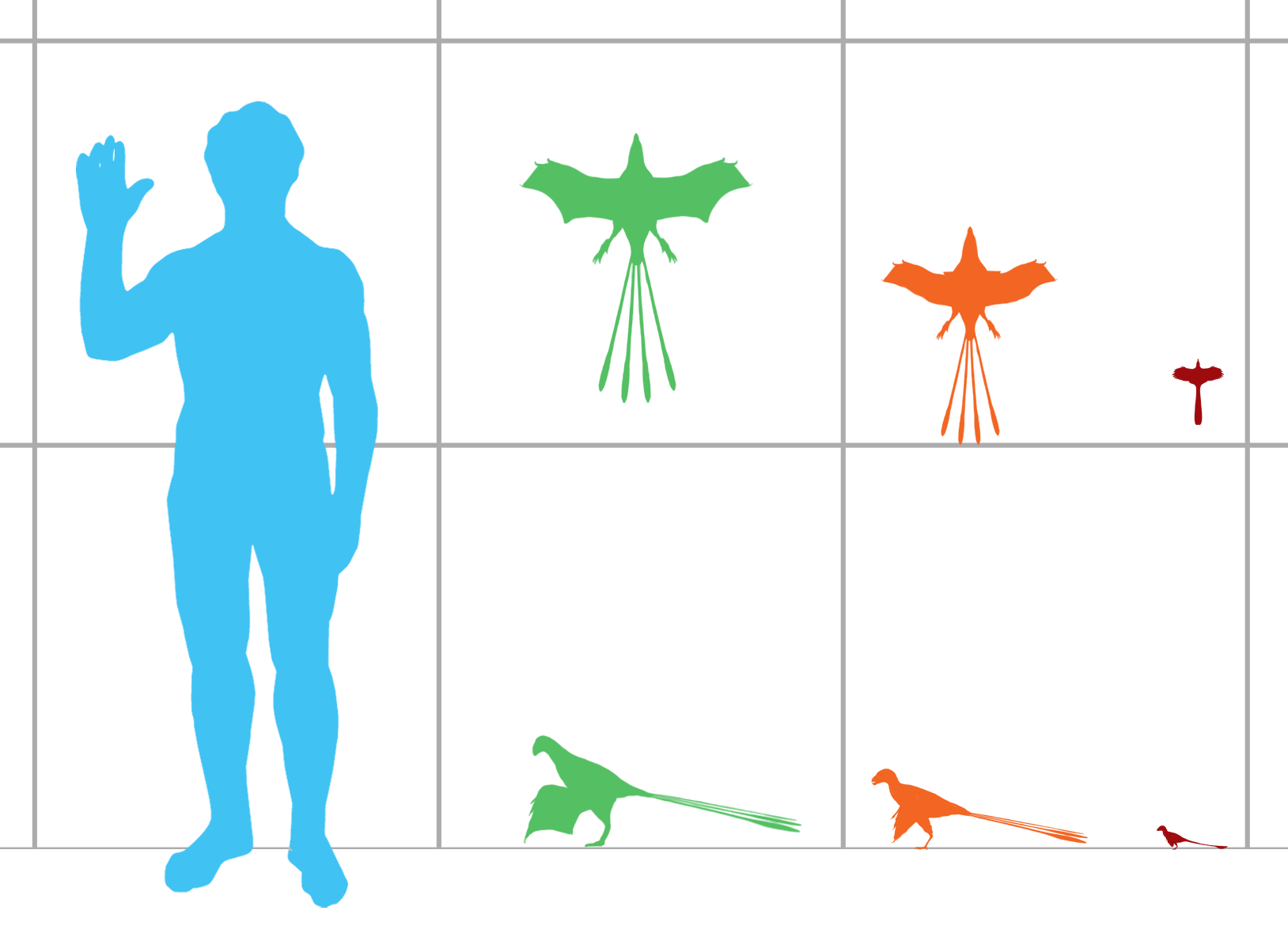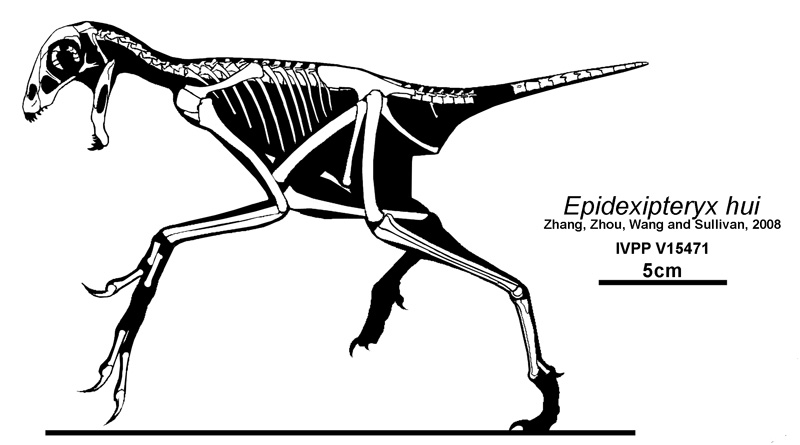|
Epidexipteryx NT
''Epidexipteryx'' is a genus of small paravian dinosaurs, known from one fossil specimen in the collection of the Institute of Vertebrate Paleontology and Paleoanthropology in Beijing. ''Epidexipteryx'' represents the earliest known example of ornamental feathers in the fossil record. Discovery The type specimen is catalog number IVPP V 15471. The specific name, ''Epidexipteryx hui'' ("Hu's display feather"), and its Chinese name ''Hushi Yaolong'' ("Hu Yaoming's dragon") were coined in memory of paleomammologist Hu Yaoming. Due to a pre-publication error,Dr. Thomas Holtz, Jr. "The mistaken scansoripterygid". Message to the Dinosaur Mailing List (October 1, 2008) a manuscript of the ''Epidexipteryx hui'' description first appeared on a preprint Web portal in late September 2008. The paper was officially published in the October 23, 2008 issue of the journal ''Nature''. Description ''E. hui'' is known from a well-preserved partial skeleton that includes four long feathers o ... [...More Info...] [...Related Items...] OR: [Wikipedia] [Google] [Baidu] |
Callovian
In the geologic timescale, the Callovian is an age and stage in the Middle Jurassic, lasting between 166.1 ± 4.0 Ma (million years ago) and 163.5 ± 4.0 Ma. It is the last stage of the Middle Jurassic, following the Bathonian and preceding the Oxfordian. Stratigraphic definitions The Callovian Stage was first described by French palaeontologist Alcide d'Orbigny in 1852. Its name derives from the latinized name for Kellaways Bridge, a small hamlet 3 km north-east of Chippenham, Wiltshire, England. The base of the Callovian is defined as the place in the stratigraphic column where the ammonite genus ''Kepplerites'' first appears, which is the base of the biozone of '' Macrocephalites herveyi''. A global reference profile (a GSSP) for the base had in 2009 not yet been assigned. The top of the Callovian (the base of the Oxfordian) is at the first appearance of ammonite species '' Brightia thuouxensis''. Subdivision The Callovian is often subdivided into three substages ( ... [...More Info...] [...Related Items...] OR: [Wikipedia] [Google] [Baidu] |
Therizinosaur
Therizinosaurs (once called segnosaurs) were large herbivorous Theropoda, theropod dinosaurs whose fossils have been found across the Early Cretaceous, Early to Late Cretaceous deposits in Asia and North America. Various features of the forelimbs, skull and pelvis unite these finds as both theropods and maniraptorans, close relatives to birds. The name of the representative genus, ''Therizinosaurus'', is derived from the Ancient Greek , Greek (, 'to reap' or 'scythe')Translated paper and (, 'lizard'). The older representative, ''Segnosaurus'', is derived from the Latin ('slow') and the Greek . History of research [...More Info...] [...Related Items...] OR: [Wikipedia] [Google] [Baidu] |
Epidexipteryx
''Epidexipteryx'' is a genus of small paravian dinosaurs, known from one fossil specimen in the collection of the Institute of Vertebrate Paleontology and Paleoanthropology in Beijing. ''Epidexipteryx'' represents the earliest known example of ornamental feathers in the fossil record. Discovery The type specimen is catalog number IVPP V 15471. The specific name, ''Epidexipteryx hui'' ("Hu's display feather"), and its Chinese name ''Hushi Yaolong'' ("Hu Yaoming's dragon") were coined in memory of paleomammologist Hu Yaoming. Due to a pre-publication error,Dr. Thomas Holtz, Jr. "The mistaken scansoripterygid". Message to the Dinosaur Mailing List (October 1, 2008) a manuscript of the ''Epidexipteryx hui'' description first appeared on a preprint Web portal in late September 2008. The paper was officially published in the October 23, 2008 issue of the journal ''Nature''. Description ''E. hui'' is known from a well-preserved partial skeleton that includes four long feathers o ... [...More Info...] [...Related Items...] OR: [Wikipedia] [Google] [Baidu] |
Epidexipteryx NT
''Epidexipteryx'' is a genus of small paravian dinosaurs, known from one fossil specimen in the collection of the Institute of Vertebrate Paleontology and Paleoanthropology in Beijing. ''Epidexipteryx'' represents the earliest known example of ornamental feathers in the fossil record. Discovery The type specimen is catalog number IVPP V 15471. The specific name, ''Epidexipteryx hui'' ("Hu's display feather"), and its Chinese name ''Hushi Yaolong'' ("Hu Yaoming's dragon") were coined in memory of paleomammologist Hu Yaoming. Due to a pre-publication error,Dr. Thomas Holtz, Jr. "The mistaken scansoripterygid". Message to the Dinosaur Mailing List (October 1, 2008) a manuscript of the ''Epidexipteryx hui'' description first appeared on a preprint Web portal in late September 2008. The paper was officially published in the October 23, 2008 issue of the journal ''Nature''. Description ''E. hui'' is known from a well-preserved partial skeleton that includes four long feathers o ... [...More Info...] [...Related Items...] OR: [Wikipedia] [Google] [Baidu] |
Oviraptorosauria
Oviraptorosaurs ("egg thief lizards") are a group of feathered maniraptoran dinosaurs from the Cretaceous Period of what are now Asia and North America. They are distinct for their characteristically short, beaked, parrot-like skulls, with or without bony crests atop the head. They ranged in size from ''Caudipteryx'', which was the size of a turkey, to the 8-meter-long, 1.4-ton ''Gigantoraptor''. The group (along with all maniraptoran dinosaurs) is close to the ancestry of birds. Some researchers such as Maryanska ''et al'' (2002) and Osmólska ''et al.'' (2004) have proposed that they may represent primitive flightless birds.Osmólska, Halszka, Currie, Philip J., Brasbold, Rinchen (2004) "The Dinosauria" Weishampel, Dodson, Osmólska. "Chapter 8 Oviraptorosauria" University of California Press. The most complete oviraptorosaur specimens have been found in Asia. The North American oviraptorosaur record is sparse.Varricchio, D. J. 2001. Late Cretaceous oviraptorosaur (Theropoda) ... [...More Info...] [...Related Items...] OR: [Wikipedia] [Google] [Baidu] |
Deinonychosauria
Deinonychosauria is a clade of paravian dinosaurs which lived from the Late Jurassic to the Late Cretaceous periods. Fossils have been found across the globe in North America, Europe, Africa, Asia, South America, and Antarctica,Case, J.A., Martin, J.E., and Reguero, M. (2007). "A dromaeosaur from the Maastrichtian of James Ross Island and the Late Cretaceous Antarctic dinosaur fauna." Pp. 1–4 in Cooper, A., Raymond, C., and Team, I.E. (eds.), ''Antarctica: a Keystone in a Changing World – Online Proceedings for the Tenth International Symposium on Antarctic Earth Sciences'', U.S. Geological Survey Open-File Report 2007-1047, SRP 083. U.S. Geological Survey, Washington, D.C. with fossilized teeth giving credence to the possibility that they inhabited Australia as well. This group of dinosaurs are known for their sickle-shaped toe claws and features in the shoulder bones. Deinonychosauria is commonly defined as all dinosaurs more closely related to dromaeosaurids (such as ''Dein ... [...More Info...] [...Related Items...] OR: [Wikipedia] [Google] [Baidu] |
Alvarezsauridae
Alvarezsauridae is a family of small, long-legged dinosaurs. Although originally thought to represent the earliest known flightless birds, they are now thought to be an early diverging branch of maniraptoran theropods. Alvarezsaurids were highly specialized. They had tiny but stout forelimbs, with compact, bird-like hands. Their skeletons suggest that they had massive breast and arm muscles, possibly adapted for digging or tearing. They had long, tube-shaped snouts filled with tiny teeth. They have been interpreted as myrmecophagous, adapted to prey on colonial insects such as termites, with the short arms acting as effective digging instruments to break into nests. ''Alvarezsaurus'', the type genus of the family, was named for the historian Gregorio Álvarez. History of study Bonaparte (1991) described the first alvarezsaurid, ''Alvarezsaurus calvoi'', from an incomplete skeleton found in Patagonia, Argentina. Bonaparte also named a family, Alvarezsauridae, to contain it. He a ... [...More Info...] [...Related Items...] OR: [Wikipedia] [Google] [Baidu] |
Polytomy
An internal node of a phylogenetic tree is described as a polytomy or multifurcation if (i) it is in a rooted tree and is linked to three or more child subtrees or (ii) it is in an unrooted tree and is attached to four or more branches. A tree that contains any multifurcations can be described as a multifurcating tree. Soft polytomies vs. hard polytomies Two types of polytomies are recognised, soft and hard polytomies. Soft polytomies are the result of insufficient phylogenetic information: though the lineages diverged at different times – meaning that some of these lineages are closer relatives than others, and the available data does not allow recognition of this. Most polytomies are soft, meaning that they would be resolved into a typical tree of dichotomies if better data were available. In contrast, a hard polytomy represents a true divergence event of three or more lineages. Applications Interpretations for a polytomy depend on the individuals, that are represe ... [...More Info...] [...Related Items...] OR: [Wikipedia] [Google] [Baidu] |
Avialae
Avialae ("bird wings") is a clade containing the only living dinosaurs, the birds. It is usually defined as all theropod dinosaurs more closely related to birds (Aves) than to deinonychosaurs, though alternative definitions are occasionally used (see below). ''Archaeopteryx lithographica'', from the late Jurassic Period Solnhofen Formation of Germany, is possibly the earliest known avialan which may have had the capability of powered flight, though it might have been a deinonychosaur instead. Several older (but non flight-capable) avialans are known from the late Jurassic Tiaojishan Formation of China, dated to about 160 million years ago. Definition Most researchers define Avialae as branch-based clade, though definitions vary. Many authors have used a definition similar to "all theropods closer to birds than to ''Deinonychus''."Weishampel, David B.; Dodson, Peter; Osmólska, Halszka (eds.) (2004). ''The Dinosauria'', Second Edition. University of California Press., 861 pp. ... [...More Info...] [...Related Items...] OR: [Wikipedia] [Google] [Baidu] |
Scansoriopterygidae
Scansoriopterygidae (meaning "climbing wings") is an extinct family of climbing and gliding maniraptoran dinosaurs. Scansoriopterygids are known from five well-preserved fossils, representing four species, unearthed in the Tiaojishan Formation fossil beds (dating to the mid-late Jurassic Period) of Liaoning and Hebei, China. '' Scansoriopteryx heilmanni'' (and its likely synonym ''Epidendrosaurus ninchengensis'') was the first non-avian dinosaur found that had clear adaptations to an arboreal or semi-arboreal lifestyle–it is likely that they spent much of their time in trees. Both specimens showed features indicating they were juveniles, which made it difficult to determine their exact relationship to other non-avian dinosaurs and birds. It was not until the description of '' Epidexipteryx hui'' in 2008 that an adult specimen was known. In 2015, the discovery of another, larger adult specimen belonging to the species '' Yi qi'' showed that scansoriopterygids were not onl ... [...More Info...] [...Related Items...] OR: [Wikipedia] [Google] [Baidu] |
Pygostyle
Pygostyle describes a skeletal condition in which the final few caudal vertebrae are fused into a single ossification, supporting the tail feathers and musculature. In modern birds, the rectrices attach to these. The pygostyle is the main component of the uropygium, a structure colloquially known as the bishop's nose, parson's nose, pope's nose, or sultan's nose. This is the fleshy protuberance visible at the posterior end of a bird (most commonly a chicken or turkey) that has been dressed for cooking. It has a swollen appearance because it also contains the uropygial gland that produces preen oil. Evolution Pygostyles probably began to evolve very early in the Cretaceous period, perhaps 140 – 130 million years ago. The earliest known species to have evolved a pygostyle were members of the Confuciusornithidae. The structure provided an evolutionary advantage, as a completely mobile tail as found in species such as '' Archaeopteryx'' is detrimental to its use for flight contro ... [...More Info...] [...Related Items...] OR: [Wikipedia] [Google] [Baidu] |
Ischium
The ischium () forms the lower and back region of the (''os coxae''). Situated below the ilium and behind the pubis, it is one of three regions whose fusion creates the . The superior portion of this region forms approximately one-third of the acetabulum. |








.jpg)